Effects of Fertilization on Ramie (Boehmeria nivea L.) Growth, Yield and Fiber Quality
Abstract
:1. Introduction
2. Materials and Methods
2.1. Experimental Design and Fertilizer Treatments
2.2. Plant Growth and Fiber Evaluation
2.3. Plant and Soil Chemical Analysis
2.4. Statistical Analysis
3. Results
3.1. Effect of Fertilizer on Plant Morphology
3.2. Effect of Fertilizer on Fiber Yield and Quality
3.3. Effect of Fertilizer on N and P Uptake and Partitioning
4. Discussion
5. Conclusions
Acknowledgments
Author Contributions
Conflicts of Interest
References
- Monteiro, S.N.; Lopes, F.P.D.; Ferreira, A.S.; Nascimento, D.C.O. Natural fiber polymer matrix composites: Cheaper, tougher, and environmentally friendly. JOM 2009, 61, 17–22. [Google Scholar] [CrossRef]
- Nam, S.; Netravali, A.N. Green composites. I. Physical properties of ramie fibers for environment-friendly green composites. Fibers Polym. 2006, 7, 372–379. [Google Scholar] [CrossRef]
- Wang, B.; Peng, D.X.; Liu, L.; Sun, Z.; Zhang, N.; Gao, S. An efficient adventitious shoot regeneration system for ramie (Boehmeria nivea Gaud) using thidiazuron. Bot. Stud. 2007, 48, 173–180. [Google Scholar]
- Food and Agriculture Organization of the United Nations. Available online: http://faostat.fao.org (accessed on 2 August 2016).
- Blackburn, R.S. Biodegradable and Sustainable Fibers; CRP Press: Cambridge, UK, 2005; pp. 70–77. [Google Scholar]
- Goda, K.; Sreekala, M.S.; Gomes, A.; Kaji, T.; Ohgi, J. Improvement of plant based natural fibers for toughening green composites-effect of load application during mercerization of ramie fibers. Compos. Part A Appl. Sci. Manuf. 2006, 37, 2213–2220. [Google Scholar] [CrossRef]
- Rong, L.; XiaoNing, T. Taking Ramie Resources Development as a Breakthrough to Speed up Soil and Water Losses Control in Slope Farmland of South China. Glob. Seabuckthorn Res. Dev. 2010, 1, 68–76. [Google Scholar]
- Subandi, M. The effect of fertilizers on the growth and the yield of ramie (Boehmeria nivea L. Gaud). Asian J. Agric. Rural Dev. 2012, 2, 126–135. [Google Scholar]
- Huang, C.; Wei, G.; Luo, Z.; Xu, J.; Zhao, S.; Wang, L.; Jie, Y. Effects of nitrogen on ramie (Boehmeria nivea) hybrid and its parents grown under field conditions. J. Agric. Sci. 2014, 6, 230–243. [Google Scholar] [CrossRef]
- Wolf, B. A comprehensive system of leaf analysis and its use for diagnosing top nutrient status. Commun. Soil Sci. Plant Anal. 1982, 13, 1035–1059. [Google Scholar] [CrossRef]
- Li, H.; Jiang, H.M.; Li, T. Broccoli plant nitrogen, phosphorous and water relations at field scale and in various growth media. Int. J. Veg. Sci. 2011, 17, 1–21. [Google Scholar] [CrossRef]
- Li, H.; Li, T.; Fu, G.; Katulanda, P. Induced leaf intercellular CO2 photosynthesis, potassium and nitrate retention and strawberry early fruit formation under macronutrient limitation. Photosyn. Res. 2013, 115, 101–114. [Google Scholar] [CrossRef] [PubMed]
- Deng, G.; Liu, L.J.; Zhong, X.Y.; Lao, C.Y.; Wang, H.Y.; Wang, B.; Zhu, C.; Shah, F.; Peng, D.X. Comparative proteome analysis of the response of ramie under N, P and K deficiency. Planta 2014, 239, 1175–1186. [Google Scholar] [CrossRef] [PubMed]
- Usherwood, N.R.; Segars, W.I. Nitrogen interaction with phosphorus and potassium for optimum crop yield, nitrogen use effectiveness and environmental stewardship. Sci. World 2001, 1, 57–60. [Google Scholar] [CrossRef] [PubMed]
- Aulakh, M.S.; Malhi, S.S. Fertilizer nitrogen use efficiency as influenced by interactions with other nutrients. In Agriculture and the Nitrogen Cycle: Assessing the Impacts of Fertilizer Use on Food Production and the Environment; Moiser, A.R., Syers, J.K., Freney, J.R., Eds.; Island Press: London, UK, 2004; pp. 181–192. [Google Scholar]
- Aulakh, M.S.; Malhi, S.S. Interactions of nitrogen with other nutrients and water: Effect on crop yield and quality, nutrient use efficiency, carbon sequestration and environmental pollution. Adv. Agron. 2005, 86, 341–409. [Google Scholar]
- Chaudhary, B.; Hovav, R.; Rapp, R.; Verma, N.; Udall, J.A.; Wendel, J.F. Global analysis of gene expression in cotton fibers from wild and domesticated Gossypium barbadense. Evol. Dev. 2008, 10, 567–582. [Google Scholar] [CrossRef] [PubMed]
- Liu, L.J.; Chen, H.Q.; Dai, X.B.; Wang, H.; Peng, D.X. Effect of planting density and fertilizer application on fiber yield of ramie (Boehmeria nivea). J. Integr. Agric. 2012, 11, 1199–1206. [Google Scholar] [CrossRef]
- Tewolde, H.; Fernandez, C.J. Fiber quality response of pima cotton to nitrogen and phosphorous deficiency. J. Plant Nutr. 2003, 26, 223–235. [Google Scholar] [CrossRef]
- Liu, L.J.; Lao, C.Y.; Zhang, N.; Chen, H.Q.; Deng, G.; Zhu, C.; Peng, D.X. The effect of new continuous harvest technology of ramie (Boehmeria nivea L. Gaud.) on fiber yield and quality. Ind. Crop. Prod. 2013, 44, 677–683. [Google Scholar] [CrossRef]
- Liu, F.; Liang, X.; Zhang, S. Accumulation and utilization efficiency of potassium in ramie varieties. J. Plant Nutr. 2000, 23, 785–792. [Google Scholar] [CrossRef]
- Macarayan, O.B. Harvesting Cycle and Nitrogen Requirement of Three Ramie (Boehmeria nivea L. Gaud.) Cultivars, 13-1; Fiber Industry Development Authority, USM Journal, University Southern Philippines: Cebu, Philippines, 2005. [Google Scholar]
- Mitra, S.; Mukesh, K.; Saha, M.; Mahapatra, B.S. Effect of irrigation and nutrient management on growth, fiber yield and water use of ramie (Boehmeria nivea). Indian J. Agric. Sci. 2014, 84, 595–601. [Google Scholar]
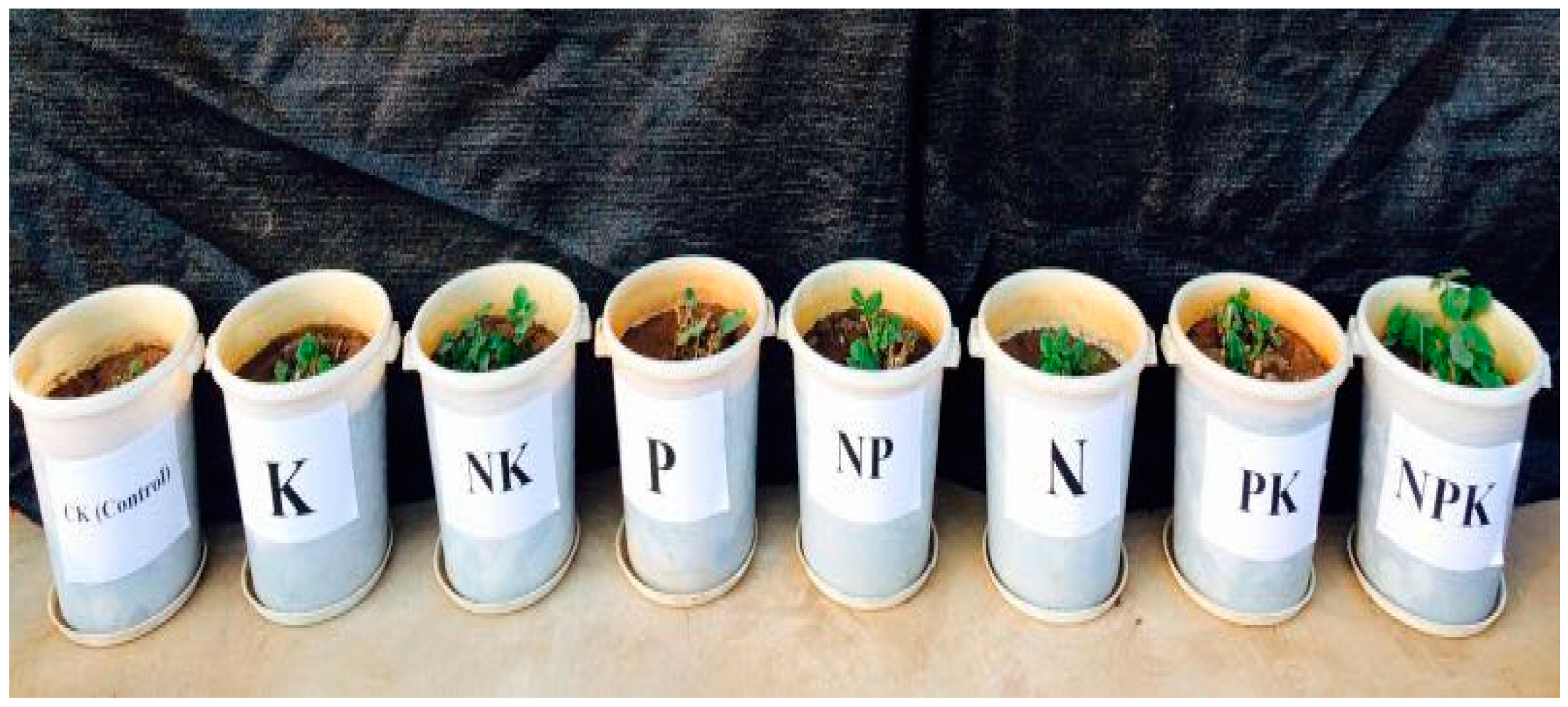
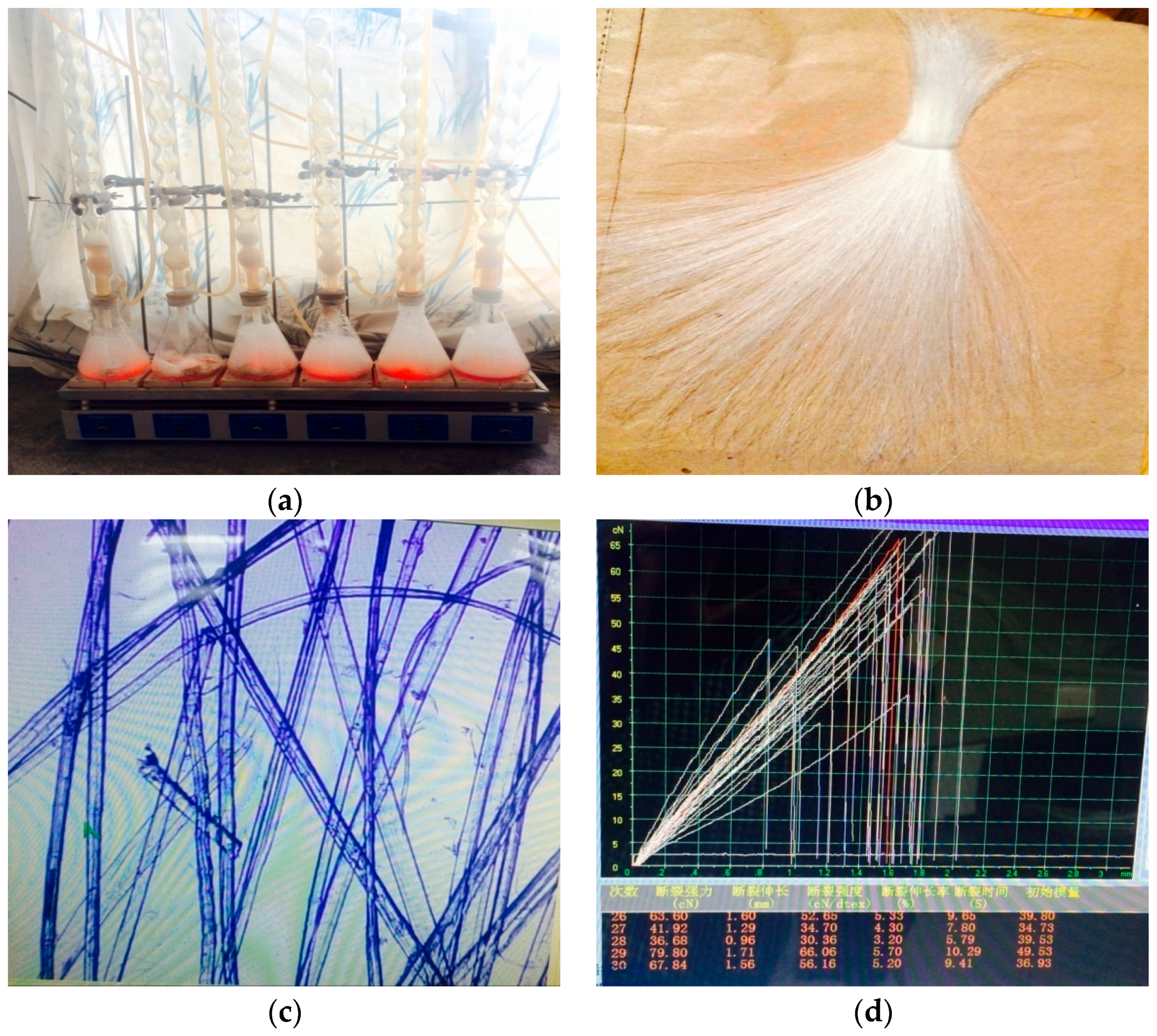
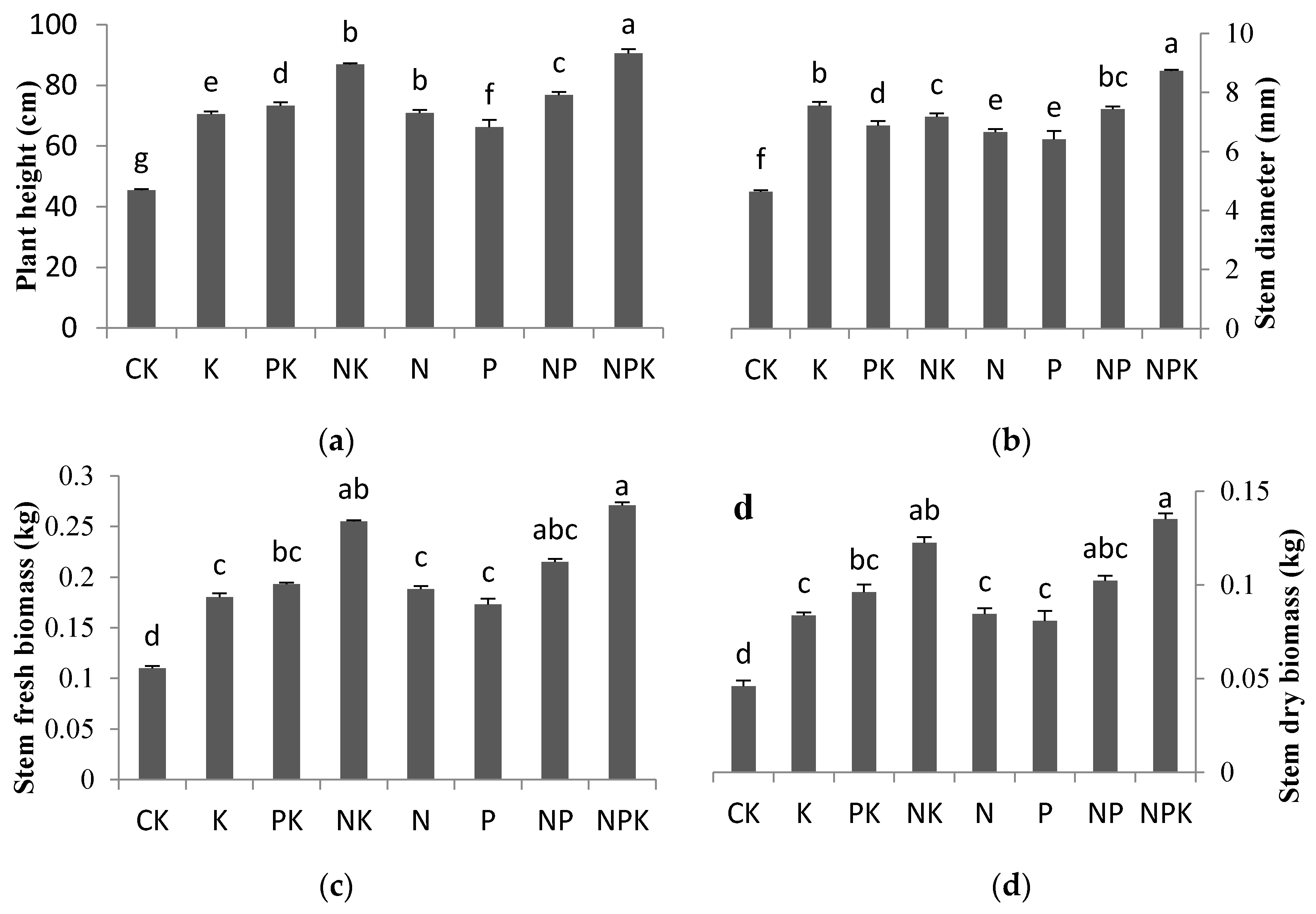
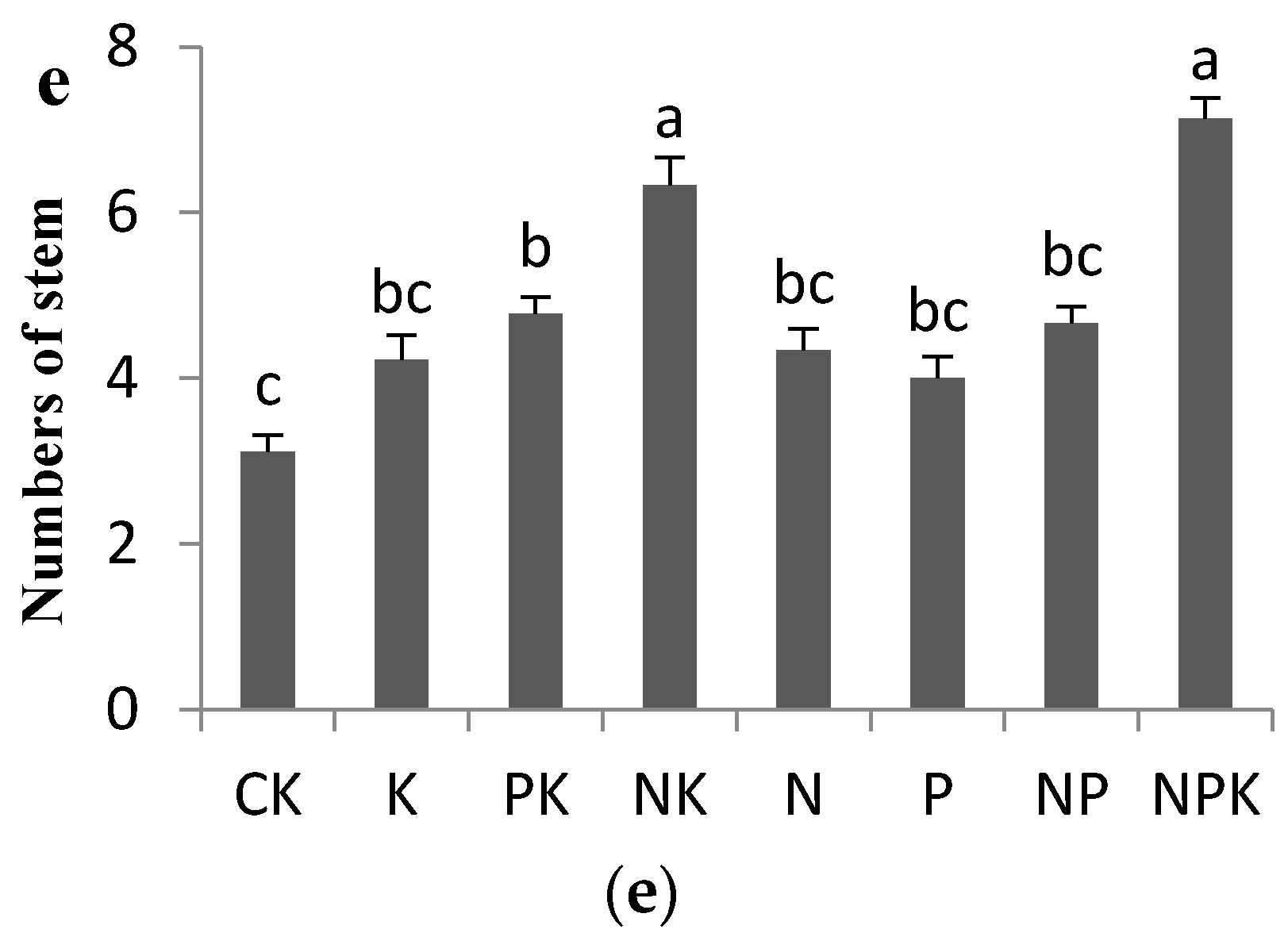
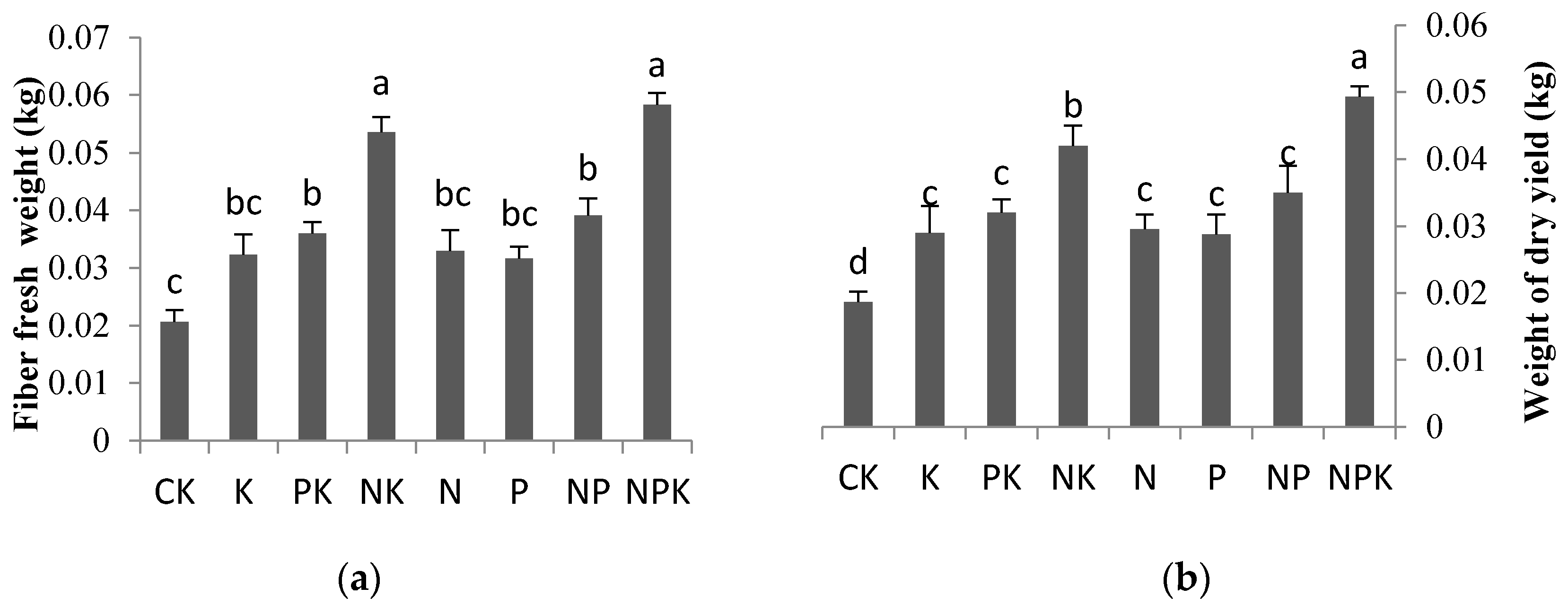
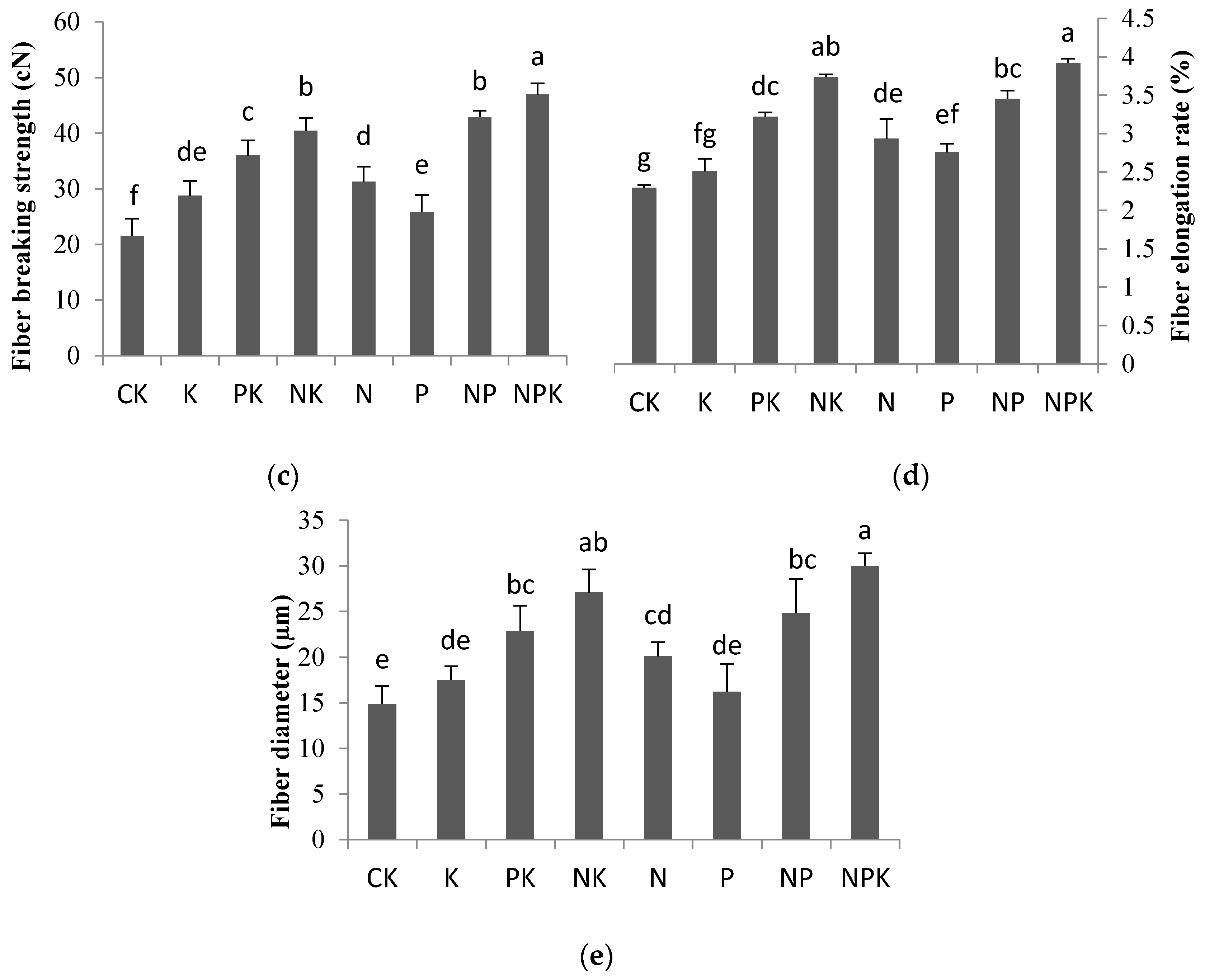
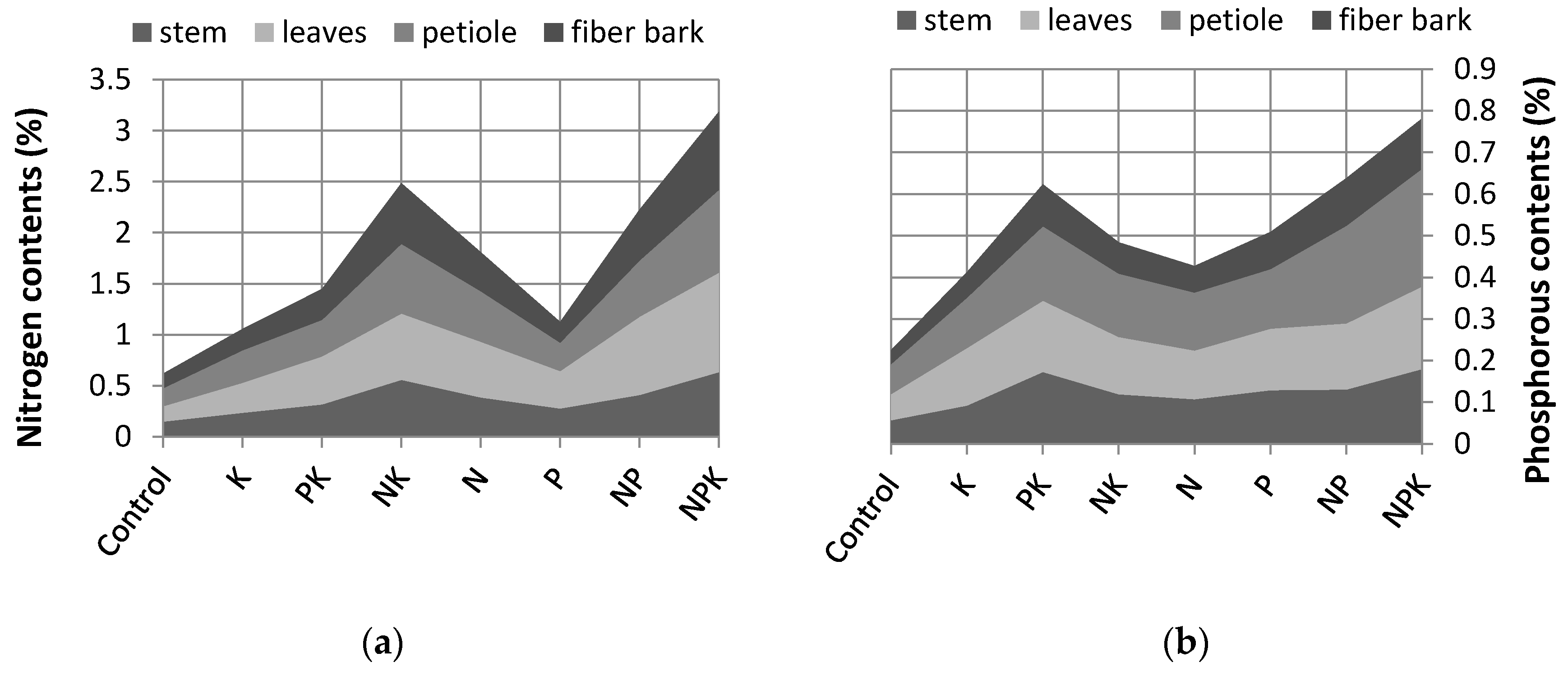
| Treatment | EC (dS/cm) | pH | Organic Matter (g/kg) | N (g/kg) | P (%) | K (g/kg) |
|---|---|---|---|---|---|---|
| Pre-Sowing | 2.1 | 5.1 | 11 | 40 | 0.18 | 61.94 |
| Post-HarvestingCK (Control) | 2 | 5.3 | 11.1 | 41 | 0.18 | 49.44 |
| K | 2.1 | 5.4 | 11.2 | 45 | 0.19 | 67.84 |
| PK | 2.2 | 5.5 | 11.5 | 46 | 0.18 | 72.84 |
| NK | 2.7 | 5.7 | 12 | 49 | 0.18 | 69.44 |
| N | 2.2 | 5.6 | 12.1 | 45 | 0.19 | 61.04 |
| P | 2.4 | 5.2 | 11.4 | 43 | 0.18 | 65.24 |
| NP | 2.7 | 5.7 | 11.6 | 47 | 0.19 | 48.24 |
| NPK | 2.7 | 5.8 | 12.2 | 48 | 0.18 | 52.74 |
| Plant Height | Biomass Weight | Stem Fresh Biomass | Numbers of Stem | Stem Diameter | Total NUptake | Total P Uptake | |
|---|---|---|---|---|---|---|---|
| Fiber breaking strength | 0.86 *** | 0.89 *** | 0.88 *** | 0.84 *** | 0.79 *** | 0.91 *** | 0.83 *** |
| Fiber elongation rate | 0.88 *** | 0.93 *** | 0.92 *** | 0.88 *** | 0.72 *** | 0.94 *** | 0.80 *** |
| Fiber diameter | 0.84 *** | 0.87 *** | 0.84 *** | 0.86 *** | 0.71 *** | 0.89 *** | 0.74 *** |
| Fiber yield fresh biomass | 0.92 *** | 0.96 *** | 0.95 *** | 0.95 *** | 0.79 *** | 0.92 *** | 0.73 *** |
| Fiber yield dry biomass | 0.92 *** | 0.94 *** | 0.93 *** | 0.94 *** | 0.83 *** | 0.92 *** | 0.79 *** |
© 2016 by the authors; licensee MDPI, Basel, Switzerland. This article is an open access article distributed under the terms and conditions of the Creative Commons Attribution (CC-BY) license (http://creativecommons.org/licenses/by/4.0/).
Share and Cite
Ullah, S.; Liu, L.; Anwar, S.; Tuo, X.; Khan, S.; Wang, B.; Peng, D. Effects of Fertilization on Ramie (Boehmeria nivea L.) Growth, Yield and Fiber Quality. Sustainability 2016, 8, 887. https://doi.org/10.3390/su8090887
Ullah S, Liu L, Anwar S, Tuo X, Khan S, Wang B, Peng D. Effects of Fertilization on Ramie (Boehmeria nivea L.) Growth, Yield and Fiber Quality. Sustainability. 2016; 8(9):887. https://doi.org/10.3390/su8090887
Chicago/Turabian StyleUllah, Sana, Lijun Liu, Sumera Anwar, Xu Tuo, Shahbaz Khan, Bo Wang, and Dingxiang Peng. 2016. "Effects of Fertilization on Ramie (Boehmeria nivea L.) Growth, Yield and Fiber Quality" Sustainability 8, no. 9: 887. https://doi.org/10.3390/su8090887





